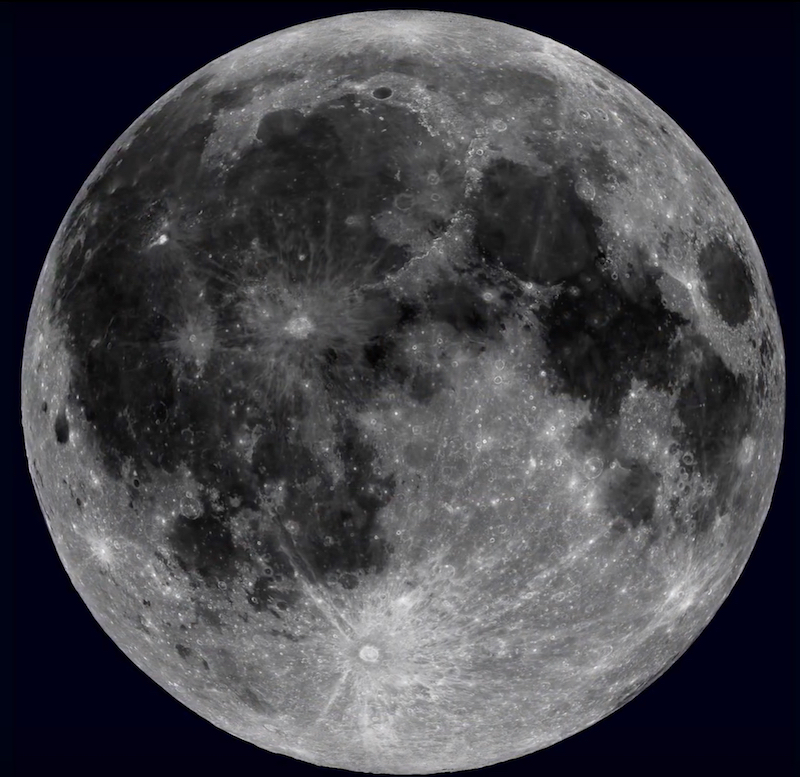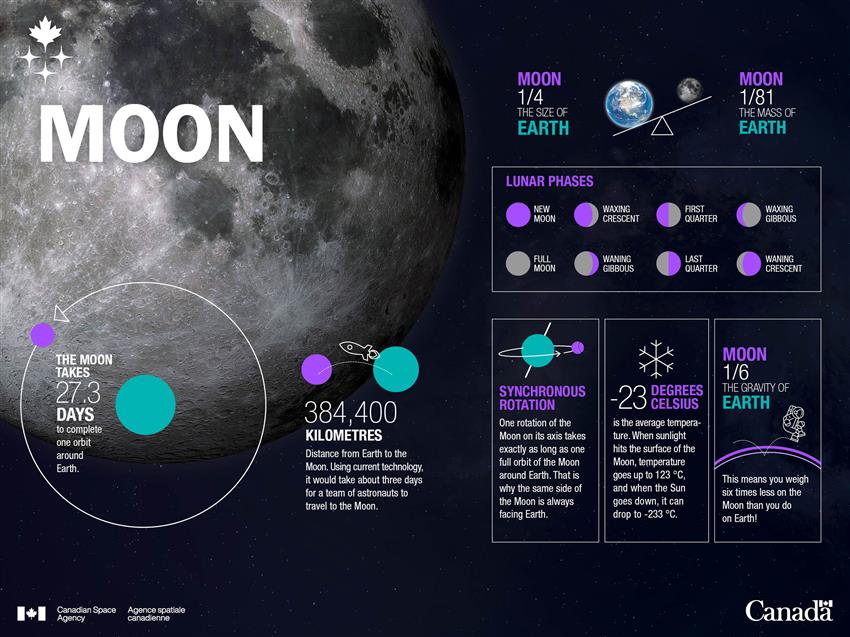The Moon
About the Moon
| Size (diameter) | 3476 km, or about 1/4 the size of Earth |
|---|---|
| Mass | 7.347 × 1022 kg, or 1/81 the mass of Earth |
| Length of a year (orbital period) | 27.3 days |
| Average distance from the Earth | 384,400 km |
| Temperature | Between -248 and 123 degrees Celsius |
In this video, we present some characteristics of the Moon, the natural satellite of Earth. (Credits: Canadian Space Agency, NASA)
Formation
The Moon is a rocky body that orbits planet Earth. It likely formed when a very large (Mars-sized) asteroid struck Earth 4.5 billion years ago, very early in our planet's history. The debris from the impact clumped together to form our natural satellite, the Moon. This shared formation explains why Earth and the Moon are made up of many of the same elements.
Orbit and rotation
The Moon is tidally locked with Earth, which means that its rotation on its axis and its orbit around Earth are perfectly synchronized, causing the same side of the Moon to always be facing Earth.
Surface
The surface of the Moon is littered with craters caused by asteroid impacts that have occurred over billions of years. Because the Moon does not have much of an atmosphere, or any liquid water or vegetation, lunar craters do not erode over time and their appearance does not change. This means that the Moon is like a cosmic time capsule. By studying it, scientists can learn more about the history of the entire solar system.

The near side of Earth's Moon, as seen using data from cameras aboard NASA's robotic Lunar Reconnaissance Orbiter spacecraft. (Credit: NASA/Goddard Space Flight Center/Arizona State University)
Eclipses
The Moon does not produce its own visible light. Instead, it acts like a mirror that reflects sunlight. Depending on the alignment of the Moon, Earth and the Sun, Earth can cast a shadow on the Moon, making it appear dimmer. This is called a lunar eclipse. Some sunlight can still stream through Earth's atmosphere during a total eclipse.
The Moon appears red during an eclipse because of the way sunlight passes through Earth's atmosphere (which scatters blue light and lets red pass through more easily).

When the Moon, Earth and the Sun perfectly align, Earth casts a shadow on the Moon, causing a lunar eclipse. When the lunar eclipse is total, the Moon appears red. (Credit: NASA)
Lunar exploration
Other than Earth, the Moon is the most explored celestial body in our solar system. The first artificial object sent to the Moon was a Soviet probe called Luna 2, which crashed onto the Moon's surface on .
A "space race" between the United States of America and the Soviet Union ensued in the following decade, culminating in the landing of two American astronauts, Neil Armstrong and Buzz Aldrin, on the Moon on .
Between and , 12 men walked on the Moon as part of the Apollo program. Since then, many other countries have either put satellites into orbit around the Moon or sent landers and rovers to study its surface. Several lunar missions have even brought Moon rocks back to Earth for scientists to study.

A close-up of the surface of the Moon taken from lunar orbit. (Credit: NASA)
Canadian connections
- An advanced version of an antenna originally designed for Canada's first satellite Alouette-I was used on the Apollo spacecraft.
- A Canadian company, Héroux-Devtek, built the landing gear of the Apollo lunar module.
- Ontario engineer Owen Maynard played a key role in the planning and design of the Apollo lunar landing module, the Eagle. He and dozens of Canadian engineers and scientists worked at NASA on many aspects of the Apollo missions, from spacecraft design to mission planning.
- Canadian flight surgeon Dr. Bill Carpentier looked after Neil Armstrong, Michael Collins and Buzz Aldrin.
Canada's role in future Moon exploration
Canada is joining the NASA-led effort to return to the Moon – to stay. Known as the Artemis campaign, this exciting next chapter of Moon exploration includes plans for a small space station known as Gateway.
Building on a legacy of leadership in space robotics, Canada is contributing Canadarm3, a smart robotic system that will help maintain Gateway, capture visiting vehicles, and enable cutting-edge science.
The Canadian Space Agency's (CSA) Lunar Exploration Accelerator Program (LEAP) is designed to prepare Canada's space sector for lunar exploration by offering a wide range of opportunities for Canadian science and technology activities in lunar orbit, on the surface of the Moon, and beyond.
In return for contributing Canadarm3, a smart robotic system, to Gateway, Canada receives a range of opportunities for lunar science, technology demonstration and commercial activities, as well as two astronaut flights to the Moon. CSA astronaut Jeremy Hansen will be part of Artemis II, the first crewed mission to the Moon since . CSA astronaut Jenni Gibbons has been assigned as the official Canadian backup for the mission. In the event that Jeremy is unable to take part in the mission, Jenni will represent Canada on Artemis II. Both of them will play a key role in defining and validating the astronaut training and processes for future Moon missions.

Text version - The Moon in numbers – Infographic
Infographic about our planet's natural satellite, the Moon. (Credit: CSA)
